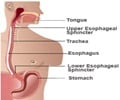A wireless device that measures the acidity of stomach contents backwashed into the esophagus allows patients to avoid some of the nose pain and throat discomfort associated with the conventional wired monitor used to manage hard-to-treat gastroesophageal reflux disease.
However, while the new technology appears be better tolerated, no studies showed that it was better for diagnosing or managing these patients, said David Mark, M.D., lead author of a new review of evidence on wireless esophageal pH monitoring for gastroesophageal reflux disease, or GERD.The systematic review was conducted by the Blue Cross and Blue Shield Association's Technology Evaluation Center, which analyzes clinical and scientific evidence to evaluate whether a technology improves health outcomes.
Physicians turn to pH monitoring — wireless or wired — for patients who have not responded to standard GERD therapy. The procedure is also used in preoperative evaluation to choose patients who will benefit most from surgery.
"After our survey of all the ways this wireless device has been studied, basically we can conclude that it was more comfortable than the wired device, that the diagnostic capacity of the wired and wireless devices seem to be similar and that there's no evidence that 48 hours was better than 24 hours," said Mark, associate director of the Technology Evaluation Center.
In conventional pH monitoring, a probe attached to a catheter is snaked through the nose and down the throat to the esophagus, the tube that carries food from the throat to the stomach. The probe and wires typically stay in place for 24 hours to send back information to a portable data recorder worn by the patient. A specialist analyzes that information to learn how often caustic stomach acid flows into the esophagus.
"You're talking about a device that's kind of unsightly for the day that you are using it, and it's definitely irritating to your sinuses and your nose," Mark said.
Advertisement
Mark's team gathered research on wireless pH monitoring to evaluate some of its purported advantages, including whether the wireless test leads to better diagnosis because patients — uninhibited by the catheter — follow more natural eating habits and physical behavior. They compared the quality of data yielded from 48-hour sessions with the wireless monitor to 24-hour sessions that are standard with wired monitors.
Advertisement
Of the nine studies included in the TEC review, two measured comfort. The more convincing was a randomized study that compared patients assessed with the wireless device with another group assessed with the wired probe. Patients implanted with the wireless device reported chest discomfort more often, but reported greater satisfaction and less interference with daily life activities.
"So you are trading 80 to 90 percent chance of nose pain and throat discomfort for about a 30 to 40 percent chance of having some discomfort behind your sternum," Mark said.
Mark said the TEC review found no studies that convincingly showed wireless pH monitoring is superior to wired technology. The evidence evaluating the effectiveness of the conventional, wired device is limited and weak, Mark said. So when you have evidence of the standard device that is equivocal, it is difficult to say whether the new technology is better at improving patient health, he added.
Weissberg said that the TEC special report was also complicated by the fact that there is no gold-standard diagnostic test for GERD. Reflux is usually diagnosed based on signs and symptoms and by how patients respond to medications or treatments that have worked in others with GERD.
There's no test to double-check the accuracy of the new technology, but after surveying the evidence, Mark's team concludes that the diagnostic performance seems to be about the same for the wired and wireless monitors.
The review also found a strong technical track-record for implanting the wireless probe and getting it to stay in place.
The studies seemed to show that, by and large, they are pretty successful in placing the device 95 to 100 percent of the time," Mark said. "Ideally you'd like the device to stay in place 24 to 48 hours, but sometimes it becomes loose and stops recording properly. The success rate of 48 hours is somewhere between 90 and 98 percent," he said.
But, Mark said, there's no firm evidence that leaving the probe in longer leads to better health, or more accurate diagnosis for the patient.
(Source: Newswise)






